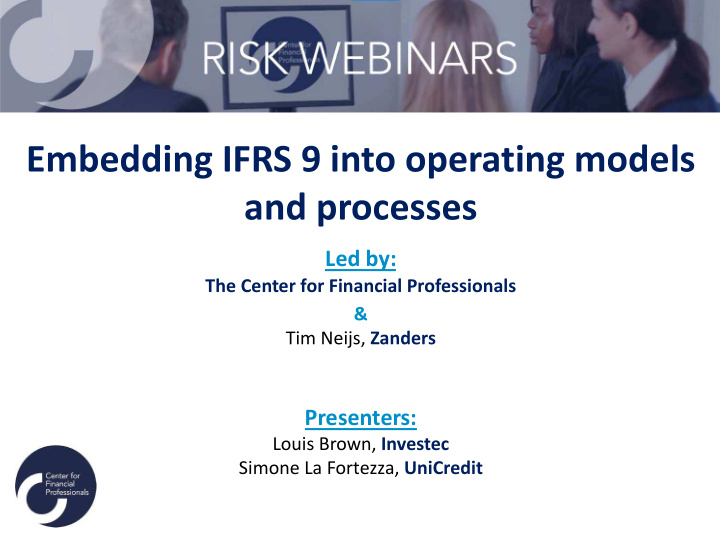



Embedding IFRS 9 into operating models and processes Led by: The Center for Financial Professionals & Tim Neijs, Zanders Presenters: Louis Brown, Investec Simone La Fortezza, UniCredit
Topics to discuss 1 • First impacts on business side – Making business under the new framework 2 • Impacts on main risk management processes (e.g. Credit Monitoring) 3 • Main impacts on financial reporting process from new LLP framework 2 UniCredit S.p.A. – public
First impacts on business side – Making business under the new 1 framework Some main impacts from IFRS9 affecting business New Classification and Impairments rules not easy to understand, while sometimes requiring action by network Understanding • More complex EL models Internal Training and Communication key to realize main new framework drivers behind changes in LLP levels and P&L/Budget results • Higher level of Provisions accounted by most of the players New Impairment models put more emphasis on some risk related drivers that need to be taken more care of when assessing business feasibility and profitability, such as (e.g.): • Higher volatility in P&L • Portfolio balance results • Eligible guarantees Assessing business • Maturity opportunities • Pricing models affected • Reimbursement schedule • New breakeven level of pricing • Risk processes/polices affected Need for business managers of closer relationship with some key stakeholders (Credit Department, Risk Management Strengthening functions, Accounting support) relationship Business-Credit functions 3 UniCredit S.p.A. – public
2 Impacts on main risk management processes (e.g. Credit Monitoring) Credit monitoring process ( Illustrative ) • Stronger impact from credit risk deterioration requires credit Risk Classification Monitoring processes to evolve in Proposal order to be more timely and more effective Risk Classification and Action Plan Proposal RM • Behavioral credit models to evolve in order to capture sign of significant deterioration before Stage allocation Risk Classification criteria are breached and Action Plan MONITORER Approval • Constant dialogue between business manager and credit monitoring manager is key to timely address Credit Proposal RM early warning signals • Also reporting at top management Approval / Granting UW level needs to evolve in order to capture new drivers and manage volatility Action Plan Follow-up 4 UniCredit S.p.A. – public
3 Main impacts on financial reporting process from new LLP framework ILLUSTRATIVE Lifetime Acc. data Perimeter LLP release to Meeting CRO - LLP LLP data parametres prod. certif. and staging Controls and m.a. CFO CFO certification segmentation IFRS 9 Interplay between risk Workload Timing and finance Increased number of Simply adding up new CRO, CFO, GDO and IT to activities and controls activities required to work together in order to needed both on Risk and calculate LLPs under IFRS9 streamline the process (vs Accounting side, including to the reporting process Silos approach) additional calculations, under IAS39, we could end elaboration of a bigger up taking up to 50% more amount of data days to complete the process! 5 UniCredit S.p.A. – public
5 th IFRS 9 Summit – Webinar UniCredit S.p.A. – public
Topics to discuss New model Stakeholders • Who are our the new stakeholders and how did we get them comfortable with the new journey? Lessons learned from the 1 st implementation release of our IFRS 9 models • Models embedded into an APIs (Application Programming Interface) Reducing the avalanche of questions from the monthly reporting process! • The team received 250 emails the first day the ECL calculation was switched on…. Confidential
New model Stakeholders Who are our the new stakeholders and how did we get them comfortable with the new journey? • Clear model change request process with • Finance Head placed on the model sign-off ownership forum committee • We try to participate in hypothetical portfolio • Financial Control has been given new tools to exercises annually review monthly Expected Credit Loss • Model Add-on process to cover model movements limitations where identified • Business and Credit Heads review ECL reports and provide sign-off • Credit and Business review ratings and LGD as well as Stage movements • Credit Officers have now become Model Owners to improve model ownership and responsibility Confidential
Lessons learned from the 1 st implementation release of our IFRS 9 models Embedded models into Application Programming Interface (APIs) • What’s an API? In computer programming, an application programming interface (API) is a set of subroutine definitions, communication protocols, and tools for building software. In general terms, it is a set of clearly defined methods of communication among various components. A good API makes it easier to develop a computer program by providing all the building blocks, which are then put together by the programmer. Pros Pros Pros • Easily Accessible tool • Can handle complicated calculations • Can handle complicated calculations • Wide usage • Code easily understood by modellers • Code easily understood by modellers Cons • Web-based distribution Cons • Difficult to run complicated calculations Cons • Distribution • Version Control difficulties • API Documentation • Weakness when used in Batch Confidential
Reducing the avalanche of questions from the monthly reporting process! The team received 250 emails the first day the ECL calculation was switched on…. • What’s the issue? • Calculations change month on month. Finance reconcile! Finance and Business feel they have lost control. • Let Financial Control and Reporting teams interrogate the monthly calculations • Created a tool to enable users (Reporting teams and Financial control) to view changes in monthly calculations. • Show’s PD, macroeconomic, LGD, Stage and Expected Credit Loss changes as well as underlying input changes. Confidential
Thank you for attending You may also be interested in… Embedding IFRS 9 into internal processes to move towards a BAU environment View full speaker line-up and agenda at: www.cefpro.com/ifrs9
Recommend
More recommend